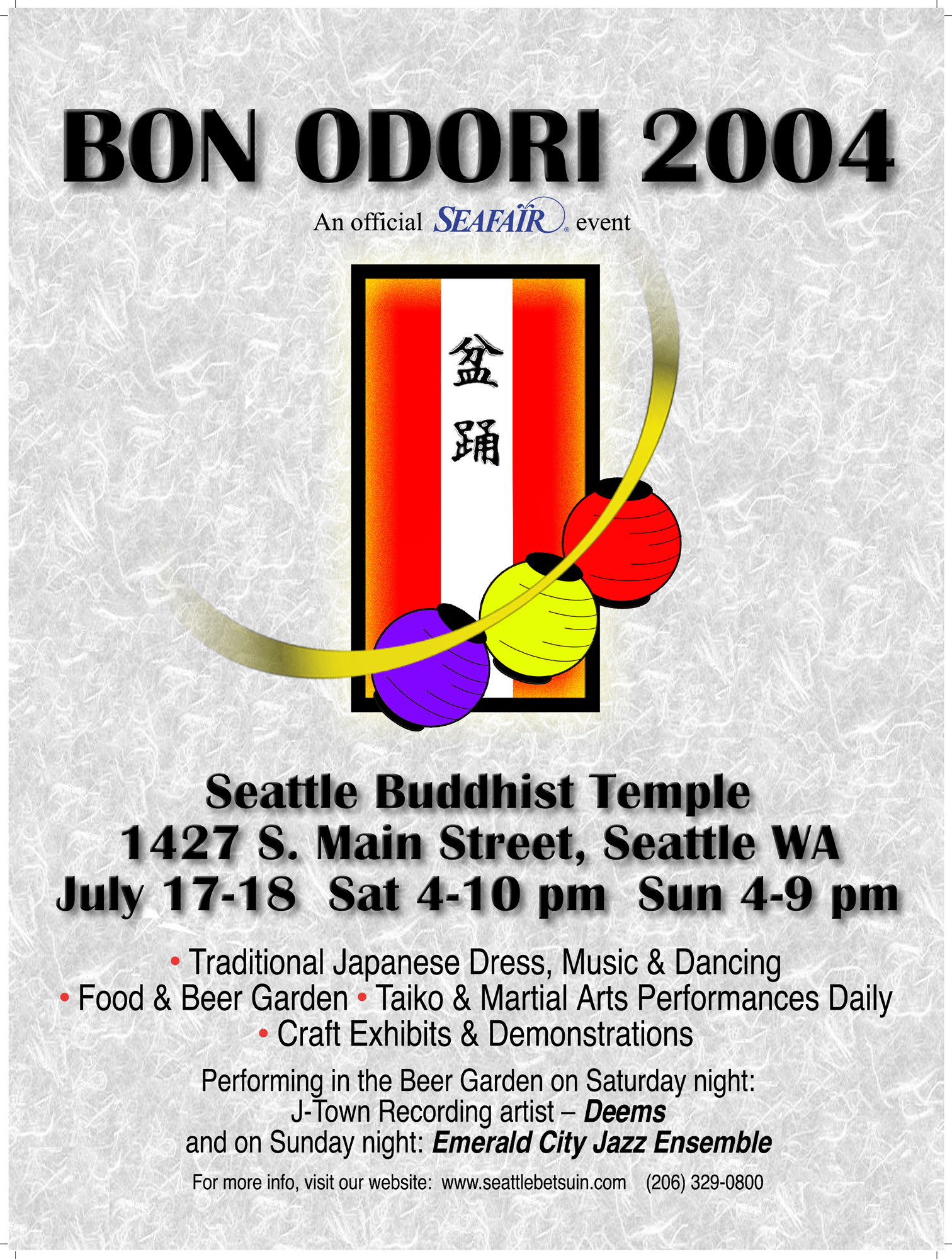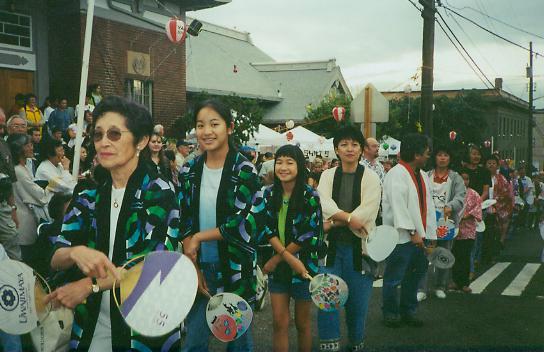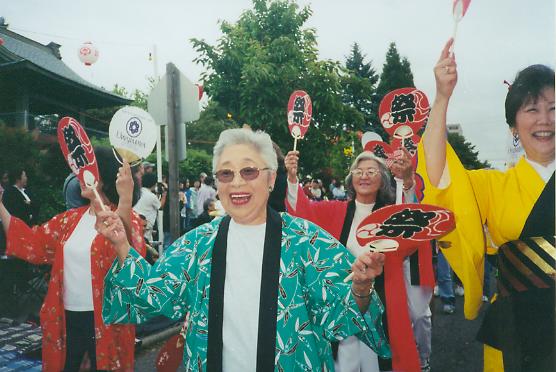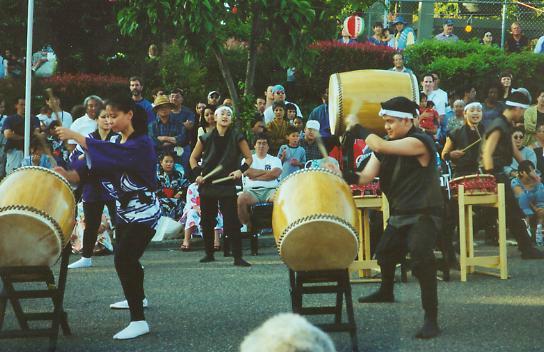
Bon
Odori History
Bon Odori Pictures
Bon Odori Details
Bon Odori Festival 2004

Bon Odori - Japanese Dance Festival - Listen to the Music Click here!

Dancers in front of the Temple

Happy Fans!

Taiko Drum performance
Cultural displays / demos: GO game
Cultural displays: Temple / community historical display
Cultural displays: "Shibai" Traditional Japanese play costumes and props
Cultural displays: "Shibai" Traditional Japanese play costumes and props
Officially sanctioned event of SeaFair
For 70 years, this annual event (in more recent years, sanctioned as a SeaFair
community event) has attracted thousands of festival goers who help celebrate
this summer tradition through song, dance and traditional Japanese foods. The
highlight
of the festival is the colorful folk dancing that takes place in the street
where young and old come together to celebrate the Japanese and Buddhist
traditions of remembering and thanking one's ancestors. The folk dancers,
dressed in brightly
colored traditional Japanese kimonos, yukatas and happi coats, dance to
traditional songs that are accompanied to the beat of a large taiko drum.
Everyone is invited to join in the dancing. Practices (see dates and times
below), for those who'd like to become familiar with the dances before the event
are provided during the two weeks preceding the event. In past years, the number
of people who have joined in the dancing, outnumbered those watching. This year
also marks a significant milestone for the host Temple for this event, its 100
year anniversary since it opened its doors.
2004 Festival Details
Bon Odori Dance practices (lead by trained instructors) are at the
Seattle Buddhist Temple Gym: Wednesday June 30 - Thursday July 1 (NO practice
Friday July 2) and Tuesday July 6 - Friday July 9 (NO practice Monday July 5),
Monday July 12 – Tuesday July 13; 7:30-9:00 pm each night.
Event Dates / Times:
Saturday, July 17, 4:00 - 10:00 pm
Sunday, July 18, 4:00 - 9:00 pm
Address / Directions:
Seattle Buddhist Temple
1427 S. Main Street
Seattle, WA 98144
206-329-0800
For detailed directions: See MapQuest
Event highlights:
• Taiko drum performances, pre-dance
(between 4:00 and 5:00 pm) Sat and Sun
and again during dance intermission ~7:30-8:00 pm each day
Taiko performance details
Saturday: One World Taiko, 4:15 / Seattle Matsuri Taiko, Intermission (~7:35)
Sunday: Seattle Kokon, 4:00 / Seattle Matsuri Taiko, Intermission (~7:10)
• Martial Arts Demonstrations, pre-dance (between 4:00 and 5:00 pm) Sat and Sun
Martial Arts Demo details
Saturday: Kendo by Cascade Kendo-kai , 4:50
Sunday: Judo by Budokan Dojo, 4:15
• Bon Odori traditional Japanese dancing starts at 5:45 pm
• Cultural displays and demonstrations in the gym
• Live Jazz performances in the Beer Garden
Saturday: Deems Tsutakawa
Sunday: Emerald City Jazz Ensemble
Food Items:
• Chicken Teriyaki Bento (chicken and rice)
• Beef bowl (niku-donburi)
• Yakisoba (chicken)
• Somen (cold noodle in soup broth)
• Teriyaki Hamburgers / Hotdogs
• Kori (flavored shaved ice)
• Beer Garden (beer / sake / plum wine)
Festival Schedule:
Food booths
open @ 4:00
Taiko drum and Martial Arts demonstration ~4:15 – 5:40
Obon service (in Temple)
Dancing begins @ 6:00
Dance order:
Mi Kokoro Ondo
Oyama Ondo
Omikoshi Ondo (2 uchiwa fans)
Hiroshima Ondo
Break
Shiawase Samba
Nembustu Daiko (2 sticks)
Yakyu Ken Odori
Intermission - Taiko Drum Performance ~7:15 – 7:30 start
Omasturi Ondo
Tokyo Ondo (towel)
Break
Isson Ippin Ondo (castanets)
Tanko Bushi
Break
Soran Bushi
Goshu Ondo
2004 Bon Odori to be Televised: Sunday
July 25, 2004 6:30 pm and again at 11:00 pm
UPN Channel 11 will be producing a 30 minute program about the Bon Odori
Festival and will feature footage from this year’s event. The programming is
being sponsored by the
Tulalip Casino. Our thanks to the Tulalip Casino for their sponsorship of
this programming.
Other links:
•
- SeaFair Festival (Bon Odori is a
sanctioned Seafair community event)
Other Bon Odori Festivals (in the Puget Sound area):
• Tacoma Bon Odori - Sunday July 11 (usually Obon Service 2:00, dancing
beginning at 5 PM)
• White River Bon Odori - Saturday, July 24
Please check back to this site for future updates.
|
1932 |
The first Bon Odori for which there is factual information, was held in front of the old temple at 1020 Main St. in Seattle. It is fairly certain that it was actually held even prior to that and verification of this is being sought. The first Bon Odori practice was lead by Mrs. Nakatani, a licensed teacher of classical Japanese dance. She had her own group of dancers, her pupils. One of her pupils, Hatsumi Tachiyama (Mrs. H Harada) took over as leader at a later time. The temple members constructed a bandstand in the center of the street and provided music with a record player and a loud speaker. |
|
|
|
|
1933 |
Bon Odori was held in front of the old temple on the unpaved street for the next few years. |
|
|
|
|
1934 |
A taiko drum made by the temple members was added to accompany the music. |
|
|
|
|
1935 |
Bon Odori became a part of the annual summer Japanese Community celebration, which was held near 6th Avenue and Main Street. A platform was set up in the street where musicians played the shamisen (traditional Japanese stringed instrument, similar to a banjo) and a drum for a crowd of dancers and on-lookers. Immigrants from various parts of Japan brought many dances that were performed just as they had been for untold generations in the areas of their Japan origin. There was a group of dancers that danced wearing “Ronin” (master-less Samurais of old) costumes. |
|
|
|
|
1941 |
World War II in the Pacific (war against Japan) forced most of the members of the Japanese community into detention at relocation camps. Bon Odori would not return to the Temple again until 1947, however the festival would continue on. |
|
|
|
|
1943 |
In August, two thousand people participated in a gigantic Bon Odori festival at the Minidoka Relocation Center in Idaho. A huge watermelon party climaxed the Obon service. |
|
|
|
|
1944 |
The Bon Odori was canceled this year in respect to the men who were lost in battle during World War II. |
|
|
|
|
1947 |
Bon Odori was reactivated in Seattle and held in the Temple gym for Temple members only. The general public was not invited to participate. |
|
|
|
|
1949 |
The first public, post
World War II Bon Odori was held in August in front of the present Temple at
14th and S. Main Street. Prizes were awarded for the best
costumes and best dancers. Some 2,500 persons attended the Bon Odori. There were more than 200 dancers. The Temple Boy Scouts, Troop 252, sold hotdogs and soda pop. Other refreshments sold at the festival included popcorn, punch, kori (shaved ice) and senbei (rice crackers). |
|
|
|
|
1950 |
In addition to the Seattle Buddhist Temple Bon Odori in July, the South Business District’s first International Carnival was held in conjunction with Seattle SeaFair in August. Among the many attractions at the Carnival was Bon Odori dancing at 6th Ave. and Main Street.
Mrs. Kiki Hagimori took charge of leading the instruction of the Bon Odori dancers. She was training 15 dance leaders, assisted by Mr. Ben Yanagimoto and Ms. Pat Kubota. |
|
|
|
|
1954 |
Bon Odori was first held in conjunction with the Seattle SeaFair program. YBA (Young Buddhists Association) and the Shoyukai (later known as the YABA – Young Adult Buddhists Association) jointly purchased booths for Bon Odori. Noodles, oden, kori, tempura, hotdogs, coffee and general merchandise were sold in the booths. |
|
|
|
|
1955 |
Prior to 1955, Bon Odori was primarily a Shoyukai project. However, after becoming a part of the Seattle SeaFair festival, it was decided that all of the affiliated organizations of the Temple would contribute towards the project. |
|
|
|
|
1957 |
Crew members of the Japanese training ship, Nippon Maru were invited participate in the Bon Odori festival. |
|
|
|
|
1959 |
The walk-in cooler (used to store food for the Bon Odori food concessions) was completed for a cost of $3000. |
|
|
|
|
1960 |
Mr. Sat Ichikawa put the first Bon Odori souvenir booklet together. The booklet was sold at Bon Odori. More than 10,000 people viewed and/or participated in the festival. A Japanese Tea Garden was constructed. Classical dancing and music were presented to an audience four times each evening. Yearly, the Bon Odori festival was evolving into a bigger program. Each food concession booth had a chairperson who was out to improve his or her own booth’s offering, which contributed to the Bon Odori’s increasing success. |
|
|
|
|
1961 |
The Seattle Times newspaper featured an article on Bon Odori food preparations. In the early 1960s (exact year uncertain), a promotional phonograph record was produced by Pacific Northwest Bell (telephone company of the time) called “The Sounds of the Fabulous Pacific Northwest”. The record included a bit of the sounds of Bon Odori, as well as Bing Crosby (who had roots in the N.W.) and other sounds such as ferry boats, seagulls, etc. |
|
|
|
|
1963 |
An article in the Seattle Post Intelligencer (newspaper) highlighted the Bon Odori festivities and some quotes from the article follow: “… in the area surrounding the roped-off street dancing section were many more exhibits of Japanese culture: a tea garden, tea ceremony, flower arrangements, native dolls, pictures and concessions with Japanese goodies for sale, Kori (chipped ice with various colored syrups in bowls) was popular with the tiny tots.” “The Japanese Buddhist Church was open too, and the crowds lined up almost as thickly there as they did for the Science Center at the World’s Fair the previous year, inching their way to the interior.” |
|
|
|
|
1964 |
Some of the proceeds from Obon years 1959-1964 were donated towards the construction of the Memorial Hall. The donation amount was nearly $22 thousand dollars. |
|
|
|
|
1966 |
A combination plate, consisting of a prawn, a piece of fish, a skewer of oden, a small piece of teriyaki chicken, onion rings and parsley tempura was offered at the Tea Garden for $1.00. Admission to the Tea Garden was 75 cents. Souvenir teapots were
imported from Japan especially for the Bon Odori Tea Garden. A Kendo stage
was set up in the new parking lot behind the temple. |
|
|
|
|
1967 |
82 Boy Scouts from Japan participated in Bon Odori, and stayed at the Temple during their tour. Mr. Yoshito Fujii (Temple President) was appointed the “Lord High Commissioner of Bon Odori” in a certificate signed by SeaFair’s Neptune Rex. |
|
|
|
|
1968 |
Bon Odori was cancelled for safety concerns due to the potential racial tension in the Temple neighborhood. Instead, the Temple members participated in the JACL (Japanese American Cultural League) Cultural Festival at the Seattle Center and danced around the International Fountain on the Center grounds. |
|
|
|
|
1970 |
After a two-year lapse, the Bon Odori was held on the last Sunday in July in front of the Temple. Concessions were minimal, with the principle emphasis placed on the religious aspects of the occasion. |
|
|
|
|
1971 |
Bon Odori became larger in scope again this year. The event began with a brief Buddhist ceremony in the Temple Hondo, which was opened to the public. A two-hour TV special was produced by VIACOM Cable and September Associates on Bon Odori. Mr. John Kusakabe served as the program host and guide. He gave a brief explanation of the history and religious significance of Obon. Rinban Ouchi, Rev. Fujii, Mr. James Komura (Temple Chairman), Mrs. Kiki Hagimori (head dance instructor), members of the Kinnara Taiko drum group, as well as the odori dancers all appeared on the tape. |
|
|
|
|
1973 |
A new Yagura (Bon Odori center stage) was constructed under the supervision of Mr. T.R. Goto. 9,000 promotional flyers were printed and distributed by the Temple members for Bon Odori publicity. Exhibits included Japanese antiques, ikebana (flower arrangements), dolls, bonsai and other arts/crafts. A full-page promotion on Bon Odori was included in the SeaFair Tall Ships program. The University of Washington held an Obon celebration that was aided by the Seattle Buddhist Temple, which provided the Yagura, Taiko drum, drummer and the dance leaders. |
|
|
|
|
1974 |
Sunset magazine published an article titled “It’s Obon Time” which included seven photos that were shot at our Bon Odori. |
|
|
|
|
1975 |
Mr. and Mrs. Jim Hata designed, printed and donated Bon Odori posters. |
|
|
|
|
1977 |
A Beer Garden was added to the Bon Odori. Part of the proceeds was donated to the Keiro nursing home. The Seattle Times newspaper interviewed Mrs. Kiki Hagimori (head dance instructor) for an article. Kiki looked for and listens to new Japanese records to plan new dances each year. The article also recognized Mr. Ben Yanagimoto as the only male of six dance instructors. He was in charge of recording and playing the dance music at Obon. |
|
|
|
|
1978 |
Bon Odori dancing in traditional costumes was performed by members of the Temple Campfire group (youth organization) at the Seattle Center House to celebrate the Campfire organization’s birthday. This event occurred in spring of this year and was separate from the actual Bon Odori festival. KIRO radio and TV did an editorial concerning the Temple’s Bon Odori festival (quotes from the editorial): “One of the things that help give our area its color, its uniqueness, is our mixture of people of various nationalities and backgrounds. One of these groups, Seattle’s Japanese community will be celebrating with a colorful festival this weekend – a 1,400 year old tradition which dates back to the early 1900’s in Seattle. It’s the Bon Odori Festival celebrating the Obon season – a time during which the people of Japanese origin reflect upon the past and show appreciation to departed loved ones for the many benefits they have inherited. It is a good time for those of us of other national origins to learn more of Japanese customs and lifestyle. The celebration includes traditional foods of the season, an invitation to visit Seattle’s Buddhist Temple, displays of Japanese floral arrangements along with bonsai trees from some of Seattle’s most valuable collections and an exquisite collection of Japanese dolls. The Bon Odori festival will be celebrated both on Saturday and Sunday on S. Main St. right here near the Seattle Buddhist Temple. We congratulate Seattle’s Japanese community on the fine jobs they do in preparing and staging this lovely festival and for the contribution they make to the community. We hope they have a great festival.” |
|
|
|
|
1979 |
KOMO TV televised Bon Odori on their “PM Northwest” program. 900 teriyaki chickens were prepared and sold at Obon. |
|
|
|
|
1980 |
Kinnara Taiko drum group was invited to and performed at Bon Odori for the next two years. |
|
|
|
|
1982 |
110 visitors from Shigaken, Japan, all wearing matching happi coats joined in with the Bon Odori dancing. Advertising hit the Seattle Transit busses. 60 exterior and 200 interior posters promoted the event. This was the last year that the Seattle Buddhist Temple's Boy Scout Drum and Bugle Corp performed. The group disbanded this year due to the dwindling size of the Boy Scout troop. |
|
|
|
|
1983 |
The Seattle Buddhist
Temple’s Matsuri Taiko drum group performed for the very first time. |
|
|
|
|
1985 |
Barazushi (mixed sushi rice on a plate) was added to the festival menu and was a hot seller. |
|
|
|
|
1987 |
Exhibit area featured item made in the Relocation camps (World War II, early 1940’s). |
|
|
|
|
1989 |
The final appearance of the Seattle Buddhist Temple’s Color Guard (all-girl flag drill team, which was originally a part of the Boy Scout Drum and Bugle Corp). A plaque was presented to Mr. Frank Fujii in appreciation for his poster and tee shirt designs for Bon Odori. |
|
|
|
|
1990 |
This was the year of the Goodwill Games in Seattle and there was a videotape produced called the “Seattle Electric Postcard” which had a section on Bon Odori showing the dancers and the Matsuri Taiko drum group. |
|
|
|
|
1991 |
Seattle Buddhist Temple Archives Committee displayed the history of Bon Odori from 1932 which included masks, photos, posters, tee shirts, dance accessories, newspaper clippings etc. The Beer Garden was discontinued and a raffle sale was introduced. |
|
|
|
|
1992 |
The Beer Garden was reactivated and the raffle sale discontinued. A larger Bon Odori historical display, including demonstrations of the Bon Odori festival food preparation, was a part of the exhibits. A sushi making demonstration was a part of this food exhibit. The mizuhiki craft (ornamental/ceremonial paper/string) was introduced in the festival craft booth. The items made using this craft included hair ornaments, magnets with ornamental designs and small framed designs. The Seattle Buddhist Women’s Association created the craft items during the course of the year in preparation for sale at the festival. |
|
|
|
|
1993 |
The Temple’s annual New Year's celebration party featured place mats, designed by Roy Shimizu to chronicle the 50 years of the Temple’s Bon Odori celebrations. The information, which was the basis for this listing, was compiled by the Temple’s Archives Committee. |
|
|
|
|
1995 |
The archive displays in the gym featured traditional Shibai (drama, theatrical) costumes and props. Shibai provided entertainment to the Japanese community members during the community's formative years. |
|
|
|
|
1997 |
A poster design contest
was held to identify designs for Bon Odori promotional poster. |
|
|
|
|
2000 |
The traditional wooden booths were replaced with pop-up canopy tents to streamline construction activities. The Temple Boy Scouts revamped the aged wiring for street lighting and booth decoration, lead by a group of Eagle Scout candidates using this as their community project. Yakisoba was added to the festival menu and was a hot seller. A very popular tee shirt and poster design, developed by Mrs. Suzanne Fujinari, was applied to tote bags, aprons and hachimaki (head bands) to be sold. The demand was so great that this year’s items sold out the first day. Kendo (bamboo sword – martial arts) demonstrations returned as a part of Bon Odori. One of the Kendo leaders of the Cascade Kendo-kai, Mr. Gary Imanishi had a grandfather that participated in past Kendo demonstrations back in the mid 1960’s. |
|
|
|
|
2001 |
A dance was created for Seattle's Bon Odori, incorporating a move from the Seattle Mariners rookie player, Ichiro Suzuki. A Hawaiian TV station was on location to do a special segment, including the Bon Odori, for an evening magazine program which highlighted Pacific Northwest activities. Information about Bon Odori was added, for the first time, to the "world wide web" (Internet) on the Seattle Betsuin web site. This year, a special recognition award was presented to Mrs. Kiki Hagimori for her many years of dedicated service. Since 1950, she has organized the dances (selection and choreography) and selected the music for the Temple's Bon Odori festivities. We "thank" Mrs. Hagimori for over 50 years of service. |
|
|
|
|
2002 |
The Seattle Betsuin was culminating a year of activities, celebrating it's 100-year Anniversary. With a one year celebration beginning in November 2001, Bon Odori, was just one of the major events highlighting this special year for the Temple. A new center stage (yagura) was built, replacing the one built in 1973. The new yagura uses modern day, quick set-up and tear-down, staging equipment. It's decorated to retain some of the original aesthetic features. The yagura houses the large taiko drum, which is played for the dance cadence. The Obon music was also updated from cassette tapes to compact discs. Mr. Robert Coffer, a friend of a Temple member, volunteered his time to do the restoration and conversion as an extension of his hobby. An interesting side note on one of the songs used at Obon (brought to light as we were trying to find a better source for taped music): As the story goes...the individual in charge of selecting dance music was visiting Japan. While riding in an elevator, he hears the music that he would like to bring back to Seattle. So he stood in the elevator, recording the elevator music because he could not find the original song elsewhere. The cultural exhibits featured a display of past Obon festival posters and t-shirts. Not every year could be accounted for, but quite an extensive display was available for viewing. The Temple's Archives Committee featured a "Shibai" artifacts display. "Shibai" refers to traditional Japanese plays, reflecting ancient Japan using hairpieces, costumes and props.
|
.